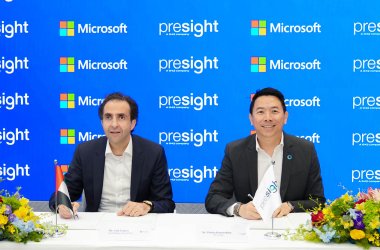 Microsoft and VMware are the enemies of interoperability, and only open source software can prevent cloud lock-in.
Microsoft and VMware are the enemies of interoperability, and only open source software can prevent cloud lock-in.
That, at least, is what Red Hat wants customers to believe, as the open source vendor unveiled private cloud software and a public cloud service while offering its usual screed against proprietary technology.
At Wednesday’s Red Hat Summit in Boston, vice president of products and technologies Paul Cormier declared “We’ve changed the world,” and mocked VMware’s “Cloud Developer’s Bill of Rights” and its statement about preventing customers from being locked in to specific products.
“Last time I checked, 90-plus-percent of their products in the enterprise were as far away from open source software as our friends up in Redmond,” Cormier said, while also chastising Microsoft for its varying statements both against and for Linux and open source over the years.
One of Red Hat’s favorite pitches is that its products let you use any combination of tools: VMware virtualisation with Red Hat Linux, or perhaps Windows with Red Hat virtualisation and middleware. Microsoft and VMware don’t allow that because they don’t have open architectures, according to Red Hat. That does, however, raise the question of how Microsoft and VMware products can be integrated with Red Hat if they’re not open in the first place.
“It’s the conundrum of interoperability,” notes IDC analyst Jean Bozman. “It works both ways. Microsoft could say they have a certain amount of interoperability with Novell Linux as well. But the industry loves battles between vendors and products.”
Red Hat’s announcements Wednesday include CloudForms, “software for building and managing a hybrid Infrastructure-as-a-Service cloud that can deploy and manage applications across heterogeneous physical servers, virtualisation platforms, and other clouds,” as noted in Red Hat’s trademark on the product name.
Essentially, this lets businesses build clouds that would approximate the capabilities of Amazon EC2 within their own networks, performing resource management across physical and virtual servers and connecting to public clouds. Red Hat Enterprise Linux, JBoss and application life-cycle management tools feature prominently in the new product package.
CloudForms “allows users to more easily configure and manage complex multi-tier applications, rather than having to independently manage large numbers of virtual servers,” Red Hat said. “Once defined, these applications can be deployed, managed and moved between different clouds, virtualization environments and bare-metal servers.”
Supported cloud providers include Amazon, IBM and NTT Communications. Red Hat and VMware virtualisation are each supported.
CloudForms is in beta and will be generally available by the end of 2011.
Red Hat also unveiled OpenShift, an online-only platform-as-a-service offering that lets developers build and host applications on Red Hat infrastructure. The service, a competitor to Windows Azure, builds upon Red Hat’s Makara acquisition, expanding it with JBoss tools and other Red Hat software, and supporting Ruby, Rails, Python, Java, PHP, MySQL and more. Red Hat claimed OpenShift “redefines the PaaS market by providing a new level of choice in languages, frameworks and clouds for developers to build, test, run and manage their applications.”
OpenShift is going into beta today and currently runs on top of Amazon EC2. When asked whether the service was affected by last month’s Amazon outage, Cormier said, “Not really. Not really.” But Red Hat will add more cloud providers on the back end so customers can have their choice of clouds beyond Amazon, he said. Red Hat is also supporting the Deltacloud API to let customers run applications on multiple cloud services.
The Amazon outage puts a spotlight on the need for more stable enterprise cloud technologies. Red Hat’s not the only one working on this problem, Bozman said, also mentioning VMware and IBM. Public clouds are good for basic file storage and application development, but may not meet the mission-critical standards of many organizations.
“When you start applying an enterprise IT sensibility, security is important, SLAs are important, and availability is important,” Bozman said.
Red Hat focused on enabling cloud computing at its Summit event both last year and this year, and it will take several years to get it right, Bozman said. Red Hat won’t have the market to itself, but the company’s focus on Linux is an advantage, Bozman said.
“Linux runs on every architecture,” she said. “It runs on ARM, it runs on RISC, it runs on Itanium, it runs on mainframes. For developers, particularly in cloud, this is going to be important, that Linux runs on everything.”
One goal is to let developers write applications in their programming language of choice without necessarily worrying about what infrastructure is underneath. But one vendor alone isn’t going to provide all the interoperability needed, Bozman said. Openness has to exist at multiple layers, including operating systems, middleware and APIs.
Enterprise customers “have Linux, they have Windows, they have mainframes, they have Unix servers,” she said. “The question is, how can they bring this together with cloud computing and break down the silos?”





